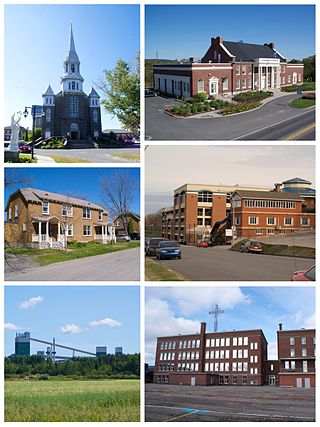
Alma is a town in Saguenay–Lac-Saint-Jean, in the Canadian province of Quebec.

Saguenay–Lac-Saint-Jean is a region in Quebec, Canada on the Labrador Peninsula. It contains the Saguenay Fjord, the estuary of the Saguenay River, stretching through much of the region. It is also known as Sagamie in French, from the first part of "Saguenay" and the last part of "Piekouagami", the Innu name for Lac Saint-Jean, with the final "e" added to follow the model of other existing region names such as Mauricie, Témiscamie, Jamésie, and Matawinie. With a land area of 98,712.71 km2 (38,113.19 sq mi), Saguenay–Lac-Saint-Jean is the third-largest Quebec region after Nord-du-Québec and Côte-Nord.

Drummondville is a city in the Centre-du-Québec region of Quebec, located east of Montreal on the Saint-François River. The population as of the Canada 2021 Census was 79,258. The mayor of Drummondville is Stéphanie Lacoste.

Granby is a town in the southwestern region of Quebec east of Montreal. According to the latest statistics from the 2021 Canadian Census, Granby has a population of 69,025. It is the administrative center of La Haute-Yamaska Regional County Municipality and is the second most populous city in The Eastern Townships after Sherbrooke. The town's name is derived from John Manners, Marquess of Granby. One of the town's main attractions is the Granby Zoo, and its well-known Lac Boivin fountain, also a notable landmark of the area. The mayor, Julie Bourdon was elected on November 7th, 2021, being the first female mayor of Granby.
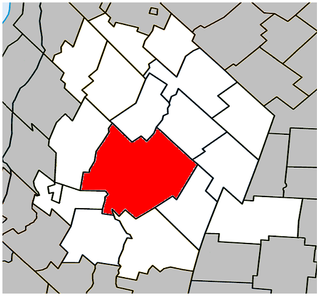
Saint-Hyacinthe is a city in southwestern Quebec east of Montreal on the Yamaska River. The population as of the 2021 Canadian census was 57,239. The city is located in Les Maskoutains Regional County Municipality of the Montérégie region, and is traversed by the Yamaska River. Quebec Autoroute 20 runs perpendicular to the river. Saint-Hyacinthe is the seat of the judicial district of the same name.

La Tuque is a city located in north-central Quebec, Canada, on the Saint-Maurice River, between Trois-Rivières and Chambord. The population was 11,129 at the 2021 Canadian census, most of which live within the urban area. At over 28,000 km2 (11,000 sq mi), it is the largest city in Canada by area.

Maria-Chapdelaine is a regional county municipality in the Saguenay–Lac-Saint-Jean region of Quebec, Canada. Its seat is in Dolbeau-Mistassini.

Amos is a town in northwestern Quebec, Canada, on the Harricana River. It is the seat of Abitibi Regional County Municipality.
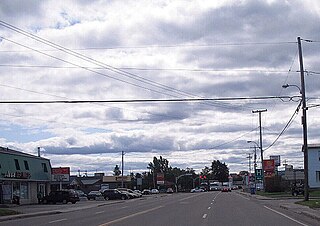
Roberval is a city on the south-western shore of Lac Saint-Jean in the Le Domaine-du-Roy Regional County Municipality of Quebec, Canada. With a population of 9,840 in the Canada 2021 Census, it is the fourth largest city on this lake after Alma, Dolbeau-Mistassini and Saint-Félicien. It is the seat of the Domaine-du-Roy RCM and the main service centre for the region with a hospital and some government services. It is also the seat of the judicial district of Roberval.

Mistissini is a Cree town located in the south-east corner of the largest natural lake in Quebec, Lake Mistassini. The town is inside the boundaries of the Baie-James Municipality and is the second largest Cree community with a population of 3,731 people in 2021. The surface area of the town is 807.75 square kilometres (311.87 sq mi).

Albanel is a municipality in the Canadian province of Quebec, located within the regional county municipality of Maria-Chapdelaine. The municipality had a population of 2,262 as of the Canada 2016 Census.

The Mistassini River is a river in central Quebec, Canada, draining into the north-western portion of Lac Saint-Jean. It is 298 kilometres (185 mi) long and has a watershed area of 21,900 square kilometres (8,500 sq mi). Its source is between Eau Froide and De Vau Lakes in the northernmost portion of the Rivière-Mistassini Unorganized Territory, just east of the vast Baie-James Municipality.
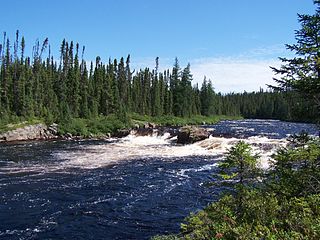
The Mistassibi River is a river in central Quebec, Canada. It is 298 kilometres (185 mi) long and has a drainage basin of 9,325 square kilometres (3,600 sq mi). Its source is an area with unnamed lakes about 50 kilometres (31 mi) east of Canso Bay of Lake Albanel, eastern neighbor of Lake Mistassini.

Desbiens is a ville in the Canadian province of Quebec, located in Lac-Saint-Jean-Est Regional County Municipality. It is on the shores of Lac Saint-Jean at the mouth of the Métabetchouane River.

Saint-Félicien is a city in the Canadian province of Quebec. The town is located within the Le Domaine-du-Roy Regional County Municipality in the Saguenay-Lac-Saint-Jean region. Its population as of 2023 is 10,226.
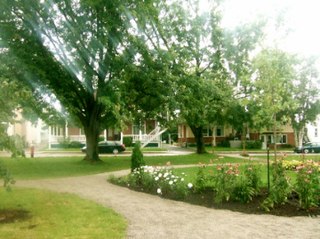
Métabetchouan–Lac-à-la-Croix is a city in Quebec, Canada, in the Saguenay–Lac-Saint-Jean region.

Saint-Gédéon or Saint-Gédéon-de-Grandmont is a municipality in Quebec, Canada, in the regional county municipality of Lac-Saint-Jean-Est and the administrative region of Saguenay–Lac-Saint-Jean. It is on the eastern shore of Lac Saint-Jean at the mouth of the Belle River.
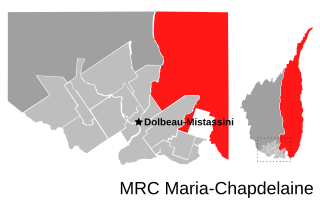
Passes-Dangereuses is an unorganized territory in the Canadian province of Quebec, located between the Peribonka River on the east and the Mistassibi River on the west.
Mistissini is a Cree village municipality in the territory of Eeyou Istchee in northern Quebec, Canada; it has a distinct legal status and classification from other kinds of village municipalities in Quebec: Naskapi village municipalities, northern villages, and ordinary villages.
The zec de la Rivière-aux-Rats is a "zone d'exploitation contrôlée" (ZEC) in the unorganized territory of Rivière-Mistassini, in the Maria-Chapdelaine Regional County Municipality, in the administrative region of Saguenay-Lac-Saint-Jean, in Quebec, in Canada.





















